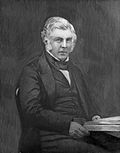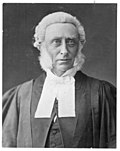Ministers
The following members served in the Stafford Ministry: [3]
| Name | Image | Office | Term |
|---|---|---|---|
| Edward Stafford |  | Member of Executive Council | 2 June 1856 – 12 July 1861 |
| Colonial Secretary | 4 November 1856 – 12 July 1861 | ||
| Henry Sewell |  | Colonial Treasurer | 2 June 1856 – 4 November 1856 |
| 25 February 1859 – 26 April 1859 | |||
| Member of Executive Council | 4 November 1856 – 26 April 1859 | ||
| Commissioner of Customs | 25 February 1859 – 26 April 1859 | ||
| Frederick Whitaker, MLC |  | Attorney-General | 2 June 1856 – 12 July 1861 |
| William Richmond |  | Colonial Secretary | 2 June 1856 – 4 November 1856 |
| Colonial Treasurer | 4 November 1856 – 25 February 1859 | ||
| 26 April 1859 – 12 July 1861 | |||
| Minister for Native Affairs | 27 August 1858 – 10 November 1860 | ||
| Commissioner of Customs | 1 January 1859 – 25 February 1859 | ||
| 26 April 1859 – 12 July 1861 | |||
| Member of Executive Council | 25 February 1859 – 12 July 1861 | ||
| John Logan Campbell |  | Member of Executive Council | 2 June 1856 – 24 November 1856 |
| Henry Tancred, MLC |  | Member of Executive Council | 5 August 1858 – 12 July 1861 |
| Secretary for Crown Lands | 19 August 1858 – 12 July 1861 | ||
| Postmaster-General | 3 November 1858 – 12 July 1861 | ||
| Lt. Colonel Robert Wynyard, CB |  | Member of Executive Council | 3 January 1854 – 1 November 1858 |
| Col. Charles Emilius Gold | Member of Executive Council | 3 November 1858 – 30 March 1861 | |
| Frederick Weld |  | Member of Executive Council | 28 July 1860 – 12 July 1861 |
| Minister for Native Affairs | 10 November 1860 – 12 July 1861 | ||
| Major-General Thomas Simson Pratt |  | Member of Executive Council | 30 March 1861 – 22 April 1861 |
| Lieut-General Duncan Cameron |  | Member of Executive Council | 22 April 1861 – 6 August 1862 |